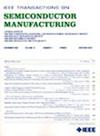Semisupervised Lithography Hotspot Detection Model Based on Dual-Branch Auxiliary Classification
IF 2.3
3区 工程技术
Q2 ENGINEERING, ELECTRICAL & ELECTRONIC
引用次数: 0
Abstract
Due to the low accuracy and high false alarm rate of conventional semisupervised lithography hotspot detection models, we propose a semisupervised hotspot detection model based on dual-branch auxiliary classification comprising a classification stream, a dual-branch auxiliary classification stream, and a clustering stream. The classification stream assigns labels to input samples. The auxiliary classification stream consisting of two branches validates the classification results. Moreover, the clustering stream estimates the confidence of the sample labels. Due to the imbalance of the dataset, the model integrates a random data augmentation method to increase the hotspot samples and thus enhance model performance. Additionally, false positive rate (FPR) is used to assess model performance across all benchmarks in the ICCAD 2012 dataset. The experimental results demonstrate that our model achieves higher accuracy and a lower FPR while requiring less overall detection and simulation time across different proportions of labeled samples compared with the state-of-the-art model.基于双分支辅助分类的半监督光刻热点检测模型
针对传统半监督光刻热点检测模型准确率低、虚警率高的问题,提出了一种基于双分支辅助分类的半监督热点检测模型,该模型由分类流、双分支辅助分类流和聚类流组成。分类流为输入样本分配标签。由两个分支组成的辅助分类流验证分类结果。此外,聚类流估计样本标签的置信度。由于数据集的不平衡性,该模型集成了随机数据增强方法来增加热点样本,从而提高模型性能。此外,假阳性率(FPR)用于评估ICCAD 2012数据集中所有基准的模型性能。实验结果表明,与最先进的模型相比,我们的模型在不同比例的标记样品上实现了更高的精度和更低的FPR,同时需要更少的总体检测和模拟时间。
本文章由计算机程序翻译,如有差异,请以英文原文为准。
求助全文
约1分钟内获得全文
求助全文
来源期刊

IEEE Transactions on Semiconductor Manufacturing
工程技术-工程:电子与电气
CiteScore
5.20
自引率
11.10%
发文量
101
审稿时长
3.3 months
期刊介绍:
The IEEE Transactions on Semiconductor Manufacturing addresses the challenging problems of manufacturing complex microelectronic components, especially very large scale integrated circuits (VLSI). Manufacturing these products requires precision micropatterning, precise control of materials properties, ultraclean work environments, and complex interactions of chemical, physical, electrical and mechanical processes.
 求助内容:
求助内容: 应助结果提醒方式:
应助结果提醒方式:


